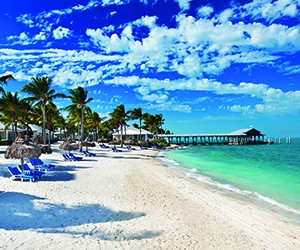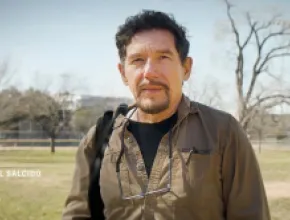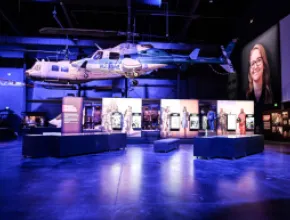Florida meets the Caribbean in the Florida Keys—if not quite geographically, then definitely in spirit, with fishing, diving, boating, beaches, fresh seafood and tropical drinks on most visitor itineraries.
Yet this 120-mile island chain is also home to some of the world’s most prized natural treasures, including the only living coral barrier reef in the continental U.S., also the third-largest reef system on the planet. Dive operators throughout the Keys can take you out to snorkel and dive the reefs, or groups can enjoy both plus kayaking and glass-bottom boat tours at John Pennekamp Coral Reef State Park in Key Largo, the first undersea park in the U.S., spanning 70 nautical square miles.
Meanwhile, birds of every size and color live and nest along the mangrove shoreline in the Keys, including the great white heron—found only in South Florida and the Caribbean—which has rebounded from near extinction thanks to the Great White Heron National Wildlife Refuge in the Lower Keys.
In fact, nurturing threatened animals is the order of the day at such Keys sanctuaries as the National Key Deer Refuge, the Florida Keys Wild Bird Rehabilitation Center and the massive National Marine Sanctuary, which basically encompasses the entire island chain and preserves five species of endangered sea turtles as well as the sensitive reefs.
“Many of our eco-organizations and attractions are large enough to accommodate groups, or they’ll send experts to the meeting site to speak during lunch and explain the importance of their programs,” says Jack Meier, destination sales manager for the Florida Keys & Key West. “A lot of meeting groups coming to the Keys will also get out there and do CSR programs, leaving a positive footprint,” Meier adds, pointing to www.keysvoluntourism.com as a resource for such program development. “We’re the Keys. We offer the great outdoors.”
Indeed, when you’re in the Keys, it’s impossible not to think about nature, surrounded as you are by water, birds and natural habitats like upland forests and inland wetlands. Following are a few of the attractions that preserve and showcase the environment—and its residents—in the Florida Keys:
Key West Tropical Forest & Botanical Garden
Touted as the only frost-free botanical garden in the continental U.S., the Key West Tropical Forest & Botanical Garden is filled with rare blooms and tropical palms and trees along with two wetland habitats, a one-acre butterfly habitat and two of the last remaining freshwater ponds in the Keys.
There are eight self-guided tours, with private tours and customized activities available for groups. The garden also can host events for up to 200.
“We have several areas of varying sizes that can be used for events,” says Rebecca Gleason, event coordinator. “We can provide tables, chairs, a dance floor and anything else the group might need. Decor can be provided, but the gardens are so lovely, there isn’t much to be added.”
Florida Keys Eco-Discovery Center, Key West
The unique biodiversity of the Florida Keys, above and below the waves, is explored at the Florida Keys Eco-Discovery Center in Key West, whose exhibits include a mock-up of Aquarius, called the world’s only underwater ocean laboratory, which demonstrates how scientists live under the sea during research expeditions.
Also on display is a 2,500-gallon reef tank with living corals and tropical fish, while land habitats are represented in exhibits of pinelands, hardwood hammocks and beach dunes.
“The center is designed to be self-guided, but guided tours of up to 30 people are available by special request,” notes Manager Craig Wanous. In addition, classroom space for 65 is offered, but requests are reviewed on a case-by-case basis, Wanous says.
The Key West Butterfly & Nature Conservatory
More than 50 different butterfly species from around the world flutter through a lush, glass-enclosed habitat at The Key West Butterfly & Nature Conservatory, an oasis of flowering plants, trees and cascading waterfalls. These delicate creatures are not collected from the wild but are bred in captivity, with excess numbers released into the wild to benefit native shrubs, flowers and nectar plants.
Meanwhile, a Learning Center features a 15-minute educational film along with displays on butterfly anatomy, physiology and the amazing migration of the Monarch, the only butterfly known to make a two-way migration, as birds do.
Receptions of up to 25 are hosted in the garden, while group tours of up to 60 can be accommodated.
Dolphin Research Center, Grassy Key
Home to a family of dolphins and California sea lions, the Dolphin Research Center on Grassy Key is all about interaction, so visitors may find themselves “shaking fins” and swimming with dolphins, learning hand signals and working alongside the trainers, or joining the research team in collecting data on these intelligent mammals.
Groups can go a step further with private tours and Q&A sessions with an education staff member.
“We can tailor a narrated presentation or interactive program,” says Mary Stella, director of media and marketing, who also notes that a visit to the center has some built-in implications for teambuilding.
“Everything we do with the animals is possible because of the mutual love and trust we have with them,” she says. “It’s a wonderful lesson for groups who are trying to build rapport. You begin to see the results of respecting each other as individuals.”
Though not set up to accommodate large groups, Stella says on-site food service and a picnic area are available for lunches and snacks.
“Groups can stay an hour or the entire day,” she says.
Marathon Wild Bird Center/Crane Point Museum and Nature Center
With the goal of rescuing sick, injured or orphaned birds, the Marathon Wild Bird Center in Marathon is an all-volunteer organization founded by rehabilitator Kelly Grinter, whose average day might include everything from setting a broken wing and hand-feeding baby owls to the greatest thrill of all—releasing a healthy bird back to the wild.
The Bird Center is part of the Crane Point Museum and Nature Center, which includes a museum of natural history and trails that wind through the property’s 63 acres of hardwood hammocks. For those who prefer to ride, trolley tours are run by knowledgeable guides who love to talk about Crane Point.
Also on staff are horticulturalists and botanists who can meet with groups, while new exhibits include a bee and pollination center.
“You can watch bees make honey,” says Charlotte Quinn, Crane Point’s chief operations officer. “We also have a lagoon full of fish and a new lionfish exhibit.”






